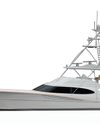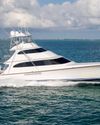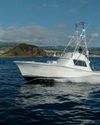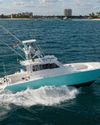
Technology and engineering continue to play a significant role in the advancement of sport-fishing boats. Improvements in those technologies and the many facets of engineering throughout a boat have given us speeds that were unheard of 20 years ago, and it's not just because we have so much more horsepower. Some of the most obvious benefits are certainly better-riding, better-performing and more-efficient boats of all sizes, thanks to some major developments in hull design as well as the use of modern composite construction materials and their application techniques. Computer-aided design programs such as Siemens Star CCM+ and the older but tried-and-true-Autocad for 2D and 3D rendering, Rhinoceros for 3D solid modeling, and Maxsurf and NAPA for bottom design all include tools to measure stability and resistance of the hull bottom. Each of these computer technologies, combined with fluid-dynamics analysis and testing platforms within the software, has given modern hull design a space-age boost of improvement.
Basically, a naval architect can predict-and prove-how the boat will run when given a certain weight and horsepower directly on the computer screen, long before the first bit of glass or timber is ever applied to the build.
THE NEED FOR SPEED
This story is from the October 2022 edition of Marlin.
Start your 7-day Magzter GOLD free trial to access thousands of curated premium stories, and 8,500+ magazines and newspapers.
Already a subscriber ? Sign In
This story is from the October 2022 edition of Marlin.
Start your 7-day Magzter GOLD free trial to access thousands of curated premium stories, and 8,500+ magazines and newspapers.
Already a subscriber? Sign In

TOURNAMENT SEASON IS HERE
Time to gear up for your favorite events

BAYLISS 76
The second project for a current Bayliss owner is in the initial phases of construction at Bayliss Boatworks in Wanchese, North Carolina.

POINTS OF NEGOTIATION IN FOREIGN CONSTRUCTION CONTRACTS
Be sure to understand the details when building a vessel in another country

MERRITT 88
A unique skybridge design from a world-famous boatbuilder

BIG BLUES AND BIG MONEY IN BERMUDA TRIPLE CROWN
Who will take home the coveted title of champion team this summer?

INSTRUCTOR SPOTLIGHT: BRAD GOODRICH & CHARLES PERRY
New school meets old school when it comes to proper angling training

RETURN OF DOUBLE HEADER
The rebirth of a classic sport-fisher amid one of the most prolific destinations for big blue marlin

THE SCIENCE OF FADS
An in-depth look at what makes these fish attractors so effective

ARMED AND DANGEROUS
In a day when piracy on the high seas still exists, traveling with firearms on board remains not only a personal choice but a safety issue as well

JIMMY'S DREAM
The planning and design of a new Merritt lost shaker of salt included catamaran,